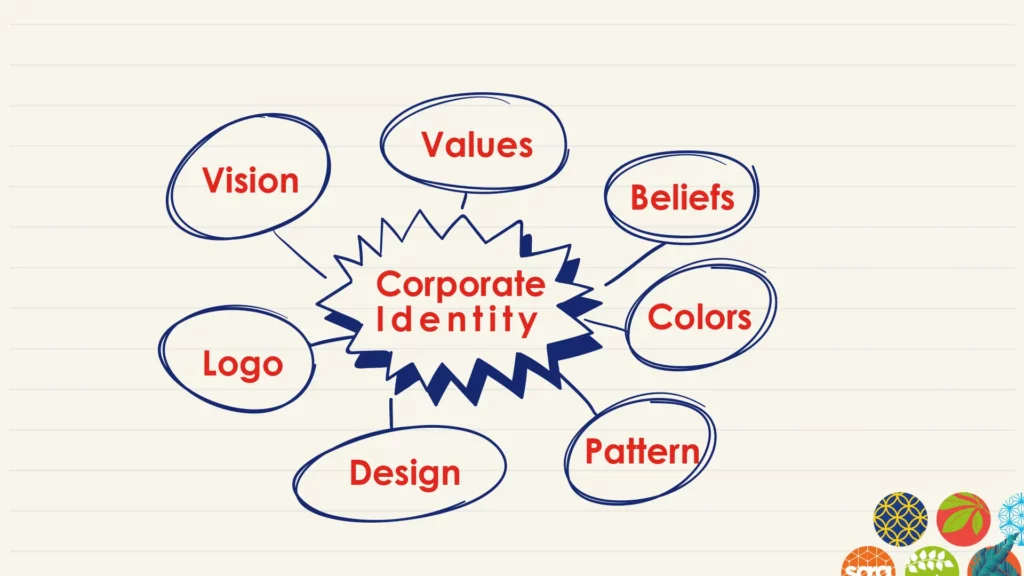Jeff Bezos once said: “A brand for a company is like a reputation for a person, you earn reputation by trying to do hard things well.” To understand how it affects your brand, you must first have a clear base of what corporate identity is. It’s simply what makes your brand unique! It’s what drives customers to choose your brand over other competitors.
Corporate identity includes several aspects including, what your brand offers and how it communicates with its audience. One of the most effective tools to represent a corporate visual identity.
how is corporate identity different from visual identity?
A visual identity is what the audience sees or perceives with their own eyes. It’s any type of visual content that brands use to communicate with their audience.
Visual identity includes the logo, patterns, textures, shapes, designs, or any other visually seen content. Visual content tends to capture the audience’s attention by 94% more than regular content.
On the other hand, a corporate identity includes any content or activity that promotes the brand’s values, beliefs, and equity. Any activity designed to highlight the uniqueness of the brand can undergo the overall identity of the brand.
Therefore, it can be said that the visual identity is part of the whole corporate identity.
How can corporate identity push your brand toward success?
One of the most obvious reasons why you should establish a strong corporate identity is to get highly recognized. An attractive identity is what sticks in the minds of your audience.
Branded giveaways are a crucial part of your corporate identity. They can take the form of brochures, flyers, notebooks, pens, or any item that reminds your audience of your brand.
According to a recent study, branded giveaways can increase your business sales by 40%
Tips for creating a unique corporate identity
Creating a unique corporate identity is essential for standing out in the competitive business world. Here are some valuable tips to help you develop a distinct and memorable corporate identity:
1. Understand Your Brand
Begin by deeply understanding your brand’s values, mission, and target audience. This foundational knowledge will guide your identity-creation process.
2. Define Your Visual Elements
Your logo, color palette, typography, and imagery should be carefully chosen to reflect your internal brand‘s personality and resonate with your audience.
3. Be Consistent
Consistency is key. Ensure that your visual elements are used consistently across all platforms – from your website to social media and marketing materials.
4. Craft a Memorable Logo
Your logo is the face of your brand. Design a logo that encapsulates your brand’s essence and is easily recognizable when corporate identity.
Read More: reasons to rebrand: why brands change their corporate identity
5. Choose Colors Wisely
Colors evoke emotions and associations. Pick a color palette that aligns with your brand’s personality and evokes the right emotions from your target audience.
6. Typography Matters
The choice of fonts can greatly impact how your brand is perceived. Opt for fonts that reflect your brand’s tone and are easy to read.
7. Develop Brand Guidelines
Create a comprehensive set of brand guidelines that outline how to use your visual elements, from sizing to spacing and placement. This ensures consistency across all materials.
8. Craft a Unique Tagline
A memorable tagline succinctly communicates your brand’s essence and value proposition.
9. Create Engaging Content
Develop high-quality content that resonates with your target audience. This can be through blog posts, videos, infographics, and social media content creation.
10. Show Your Values
Showcase your brand’s values through your actions, messaging, and engagement with customers.
Read More: Impact of Corporate Social Responsibility on Brand Identity
11. Be Authentic
Authenticity builds trust. Stay true to your brand’s values and communicate transparently with your audience.
12. Differentiate Yourself
Identify what makes your brand unique and highlight it in your corporate identity. What sets you apart from your competitors?
13. Understand Your Audience
Tailor your corporate identity to your target audience’s preferences and needs. Speak their language and cater to their expectations.
14. Be Memorable
Create a brand identity that lingers in the minds of your audience. This will help your brand stay top-of-mind when they think of your industry.
15. Stay Relevant
While consistency is important, be prepared to evolve and adapt your corporate identity as your brand grows and industry trends change.
16. Seek Professional Help
If you’re not confident in your design skills, consider hiring a professional designer or agency to help you craft a unique corporate identity.
By following these tips and dedicating time and effort to developing a strong and distinct corporate identity, you’ll be well on your way to creating a brand that stands out, resonates with your audience, and builds lasting connections.



